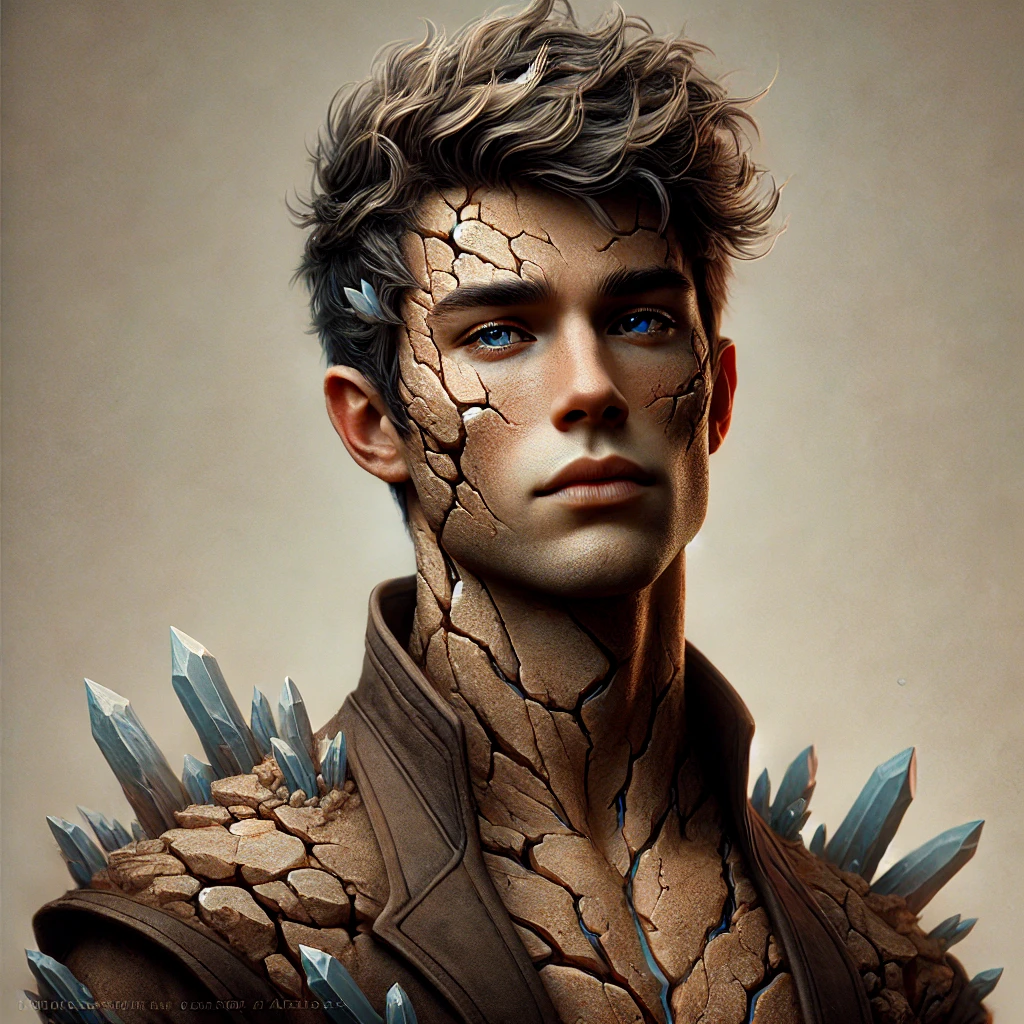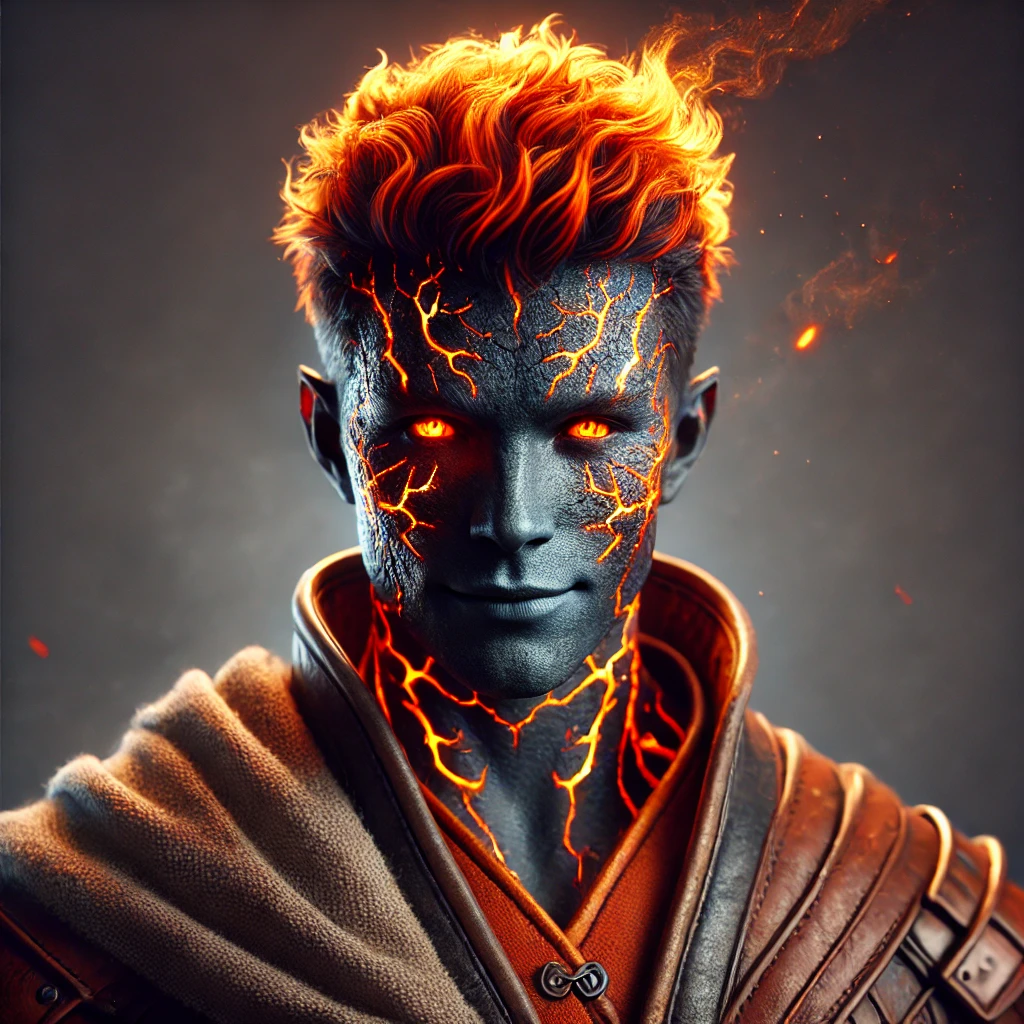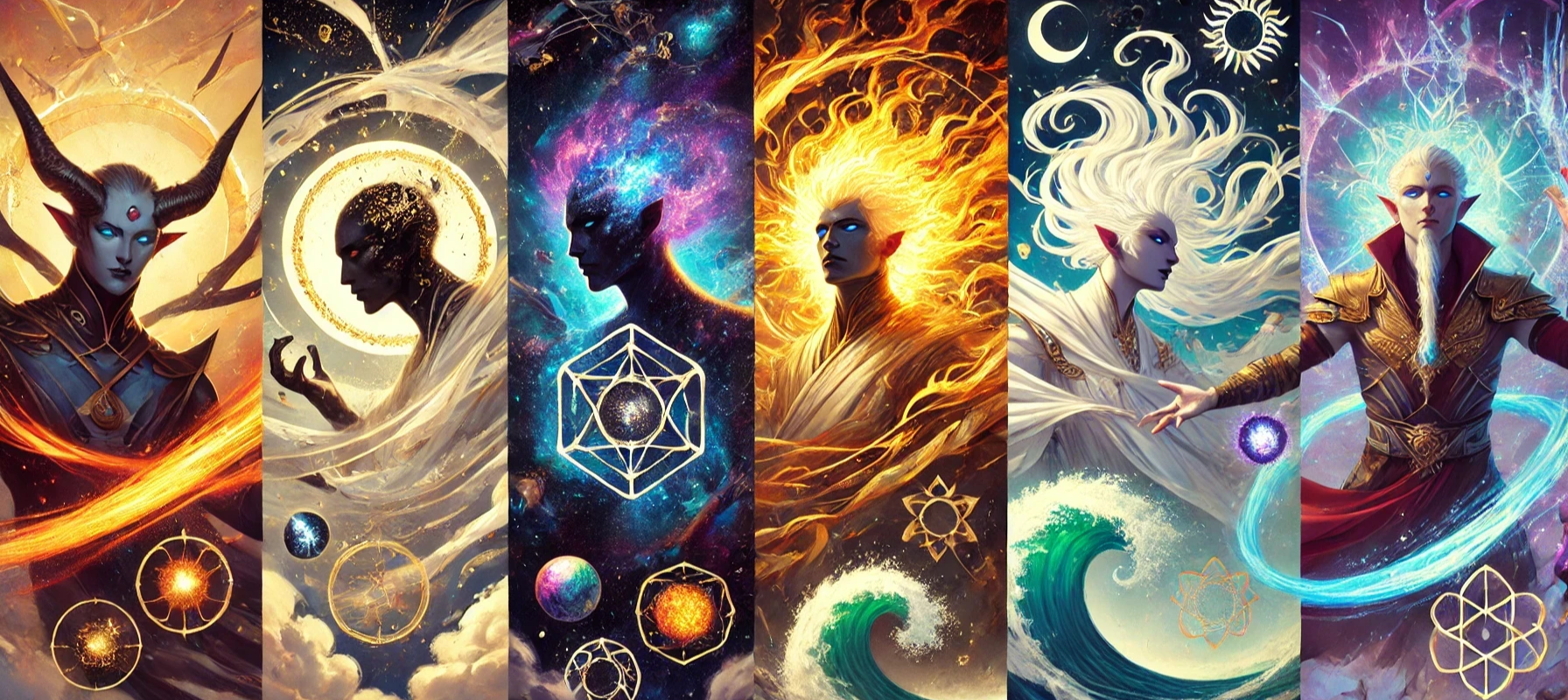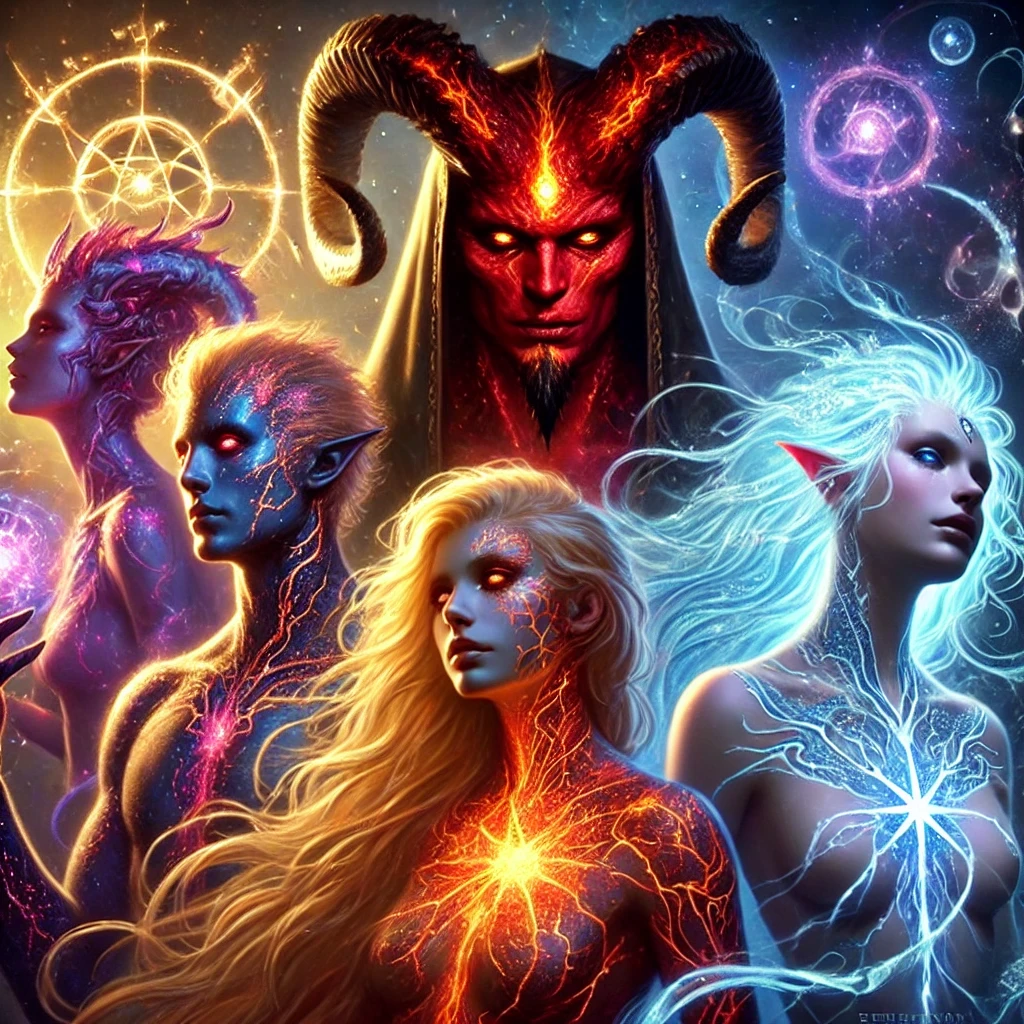The Exodari, colloquially known as the planetouched, are mortal beings whose essence is shaped by the planes beyond the material realm. They are the descendants of mortals who have been imbued with the magic and power of extraplanar forces, whether through direct lineage or the lingering influence of their environment. Though often of human descent, the Exodari include individuals from various humanoid races, each uniquely altered by the plane that touched their lineage.
Born of cosmic intersections, the Exodari are rare and enigmatic, often viewed as omens, gifts, or curses. Their supernatural traits set them apart, marking them as both wondrous and feared in the eyes of mortal society.
The creation of an Exodari varies widely. Some trace their ancestry to unions between mortals and extraplanar beings, such as celestials, fiends, or elementals. Others are the result of planar proximity: children born near ley lines, rifts, or portals may inherit the influence of these powerful energies. On occasion, planar traits emerge suddenly, passed down from a dormant bloodline or as a divine or infernal response to a mortal's deeds.
The manifestation of Exodari traits can occur across generations. Parents who appear fully mortal may still bear planar blood that surfaces unexpectedly in their offspring, often to the wonder—or horror—of their community.
Types of Exodari
Each Exodari is influenced by a specific plane of origin, shaping their abilities, appearance, and connection to the world. Their names often reflect their planar heritage:
- Tieflings: Born of the Lower Planes, tieflings bear infernal or abyssal traits, such as horns, tails, or glowing eyes. They are often feared or mistrusted, seen as harbingers of chaos and destruction.
- Aasimar: Hailing from the Upper Planes, aasimar radiate divine grace and often serve as beacons of hope. Their features are marked by celestial beauty, and they exude an aura of peace or power.
- Gloaming: Descended from the Plane of Shadow, gloaming are pale and enigmatic, with an unsettling quietness. They thrive in the darkness, often displaying abilities tied to stealth and shadow manipulation.
- Glimmerfolk: Infused with the power of the Plane of Radiance, glimmerfolk shine—sometimes literally. Their features shimmer with light, and they possess abilities tied to illumination and purity.
- Ensurii: The Ensurii are beings tied to the elemental Inner Planes. Unlike the other Exodari, their subtypes reflect specific elements:
Firetouched: Fiery eyes and blazing hair, embodying flame and passion.
Tideborn: Fluid, wave-like movements and features, tied to water and ice.
Stoneforged: Hardened skin and a sturdy presence, reflecting the earth's strength.
Stormbound: Ethereal and breezy, attuned to wind and storms.
Hybrid Elementals: Rare combinations such as Frostforged (ice) or Magmahewn (lava).
These examples only scratch the surface of Exodari diversity. Across Tanaria, countless variations exist, each reflecting the unique influence of their plane of origin. From planar realms both known and undiscovered, the Exodari continue to defy categorization, with each generation revealing new manifestations of their extraordinary heritage
The anatomy and morphology of the Exodari vary widely depending on their planar influence. While some Exodari resemble ordinary humanoids with only subtle signs of their extraplanar heritage, others are strikingly distinct, bearing features that clearly mark them as beings of another world. These traits often serve as a visual representation of their plane of origin. Fiend-Touched traits may include horns, tails, and claw-like fingernails, alongside skin that ranges from ashen to deep crimson. Fiend-touched often have sharp, angular features and eyes that glow or smolder like embers. Celestial-Touched may have bodies emit a soft radiance, and their eyes often glow faintly with divine light. Their hair may appear as threads of spun gold or silver, and their skin might carry an unearthly smoothness or faint shimmer. The Ensurii’s morphology depends entirely on their elemental alignment:
- Firetouched: Their bodies radiate heat, and their hair flickers like flames. Some have cracks in their skin that glow with inner fire.
- Tideborn: Their skin feels cool and smooth, with rippling patterns resembling waves or ice crystals.
- Stoneforged: Their features are angular and solid, with rough, stone-like textures and earthy tones.
- Stormbound: Their hair moves as if caught in an eternal breeze, and their eyes shimmer like lightning in a stormy sky.
- Hybrids: These beings exhibit combinations of traits, such as magma veins or frost-covered extremities.
The reproduction of the Exodari is a fascinating blend of biological inheritance and magical influence, shaped by their planar origins. As beings capable of interbreeding with most humanoid species, their offspring often inherit traits tied to their extraplanar ancestry. However, the manifestation of these traits can be unpredictable, depending on the strength of the planar bloodline and environmental factors.
When an Exodari pairs with a humanoid, their child may fully inherit Exodari traits, carry latent planar influences that remain dormant for generations, or appear entirely mundane. Pairings between two Exodari of the same plane typically produce offspring with pronounced planar characteristics, while unions between different types of Exodari can result in unique hybrid traits or alignment with one parent’s plane. Dormant planar bloodlines often resurface unexpectedly, leading to surprise when a child suddenly displays traits of a forgotten ancestry.
Magical factors also influence reproduction. Proximity to ley lines or planar rifts during conception or childbirth can strengthen the Exodari’s connection to their plane of origin, a phenomenon some communities intentionally encourage through rituals. This mystical aspect of their genetics reflects their deep tie to the planes, where their lineage is shaped as much by magic as by biology.
In rare cases, Exodari children are born not from planar lineage but through exposure to powerful extraplanar energies, such as near a rift or during a surge of planar magic. These children, considered anomalies, are often viewed as miraculous or unnatural, depending on cultural perspectives.
Overall, the genetics and reproduction of the Exodari underscore their role as bridges between the material and planar realms, with their traits serving as a living testament to the profound influence of the planes on mortal life.
The Exodari have existed for as long as the planes have intersected with the material world. Their origins are deeply tied to the moments when the veil between the realms thinned, allowing the elemental, divine, and infernal forces of the planes to influence mortal lives. Their presence is as much a reflection of these cosmic interactions as it is of the societies that encountered them.
The earliest records of Exodari are steeped in myth, with tales of planar beings stepping through rifts or mortals being imbued with planar magic in the wake of celestial events. In those ancient times, Exodari were often revered as living embodiments of their planar heritage, serving as guides to elemental forces, messengers of celestial will, or harbingers of infernal power. They were protectors of ley lines, custodians of planar rifts, and intermediaries between mortals and the beings of the outer planes.
As time passed and planar phenomena grew rarer, attitudes toward the Exodari shifted. In some regions, they remained revered, their abilities celebrated and integrated into society. Fire-aligned Exodari forged legendary weapons; water-aligned descendants navigated vast oceans, their skills indispensable to explorers and merchants. Those tied to the celestial or shadow planes were often seen as spiritual leaders or oracles. In these places, the Exodari thrived, their contributions leaving an indelible mark on history.
However, in other cultures, the Exodari became symbols of fear or suspicion. The unpredictability of their births, the rarity of their kind, and the strangeness of their abilities made them targets of prejudice. In eras of planar instability, they were often scapegoated, blamed for disasters or upheavals. This led to persecution, forced exile, or the need for secrecy. In some regions, Exodari formed hidden enclaves to preserve their heritage, living apart from societies that misunderstood or exploited them.
Despite these challenges, the Exodari proved resilient. In more enlightened times, they became critical to the advancement of magic, culture, and technology. Their unique connection to the planes made them natural innovators, their abilities shaping the evolution of society. Air-touched Exodari, for example, played pivotal roles in early experiments with airships and weather prediction, while shadow-aligned descendants developed new techniques for stealth and subterfuge.
Today, the Exodari remain rare but integral to the world’s fabric. Their presence, whether in isolation or integrated into society, is a living reminder of the planes’ enduring influence. They embody a history of adaptation, perseverance, and the balance between mortal and extraplanar forces—a legacy as multifaceted as the planes themselves.







Comments